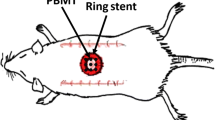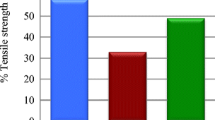Abstract
Wound healing is a highly orchestrated process including complex and coordinated interactions involving peptide growth factors of which transforming growth factor-beta (TGF-beta) is one of the most important modulators. Exogenous TGF-beta treatment has been shown to accelerate wound healing in normal and impaired animal models. Nitric oxide (NO) also plays a key role in wound healing. The objective of this study is to examine the effects of exogenous TGF-beta 1 treatment on NO and lipid peroxidation levels in the process of oral wound healing on different days. In this study, we used 5-month-old New Zealand albino male rabbits. After a standard surgical incision in the diestema region, the rabbits were divided into controls and TGF-beta 1 implanted groups. NO levels and malondialdeyhde (MDA) levels which are indicators of lipid peroxidation were determined by spectrophotometry. In the TGF-beta 1 implanted groups, both NO and MDA levels significantly increased only on the third day after wounding when compared to control groups. We found decreased MDA levels parallel to NO levels on the fifth day after wounding. These findings suggest that TGF-beta 1 affects mucosal wound healing by altering NO production on different days of wounding. TGF-beta 1 may regulate NO production by its dual effect in as both an activator and inhibitor an in oral mucosal healing.
Similar content being viewed by others
References
Akbulut KG, Gönül B, Türkyılmaz A, Çelebi N (2002) The role of EGF formulation on stress ulcer healing of the gastric mucosa. Surg Today 32:880–883
Alemdaroglu C, Degim Z, Celebi N, Zor F, Ozturk S, Erdogan D (2006) An investigation on burn wound healing in rats with chitosan gel formulation containing epidermal growth factor. Burns 32:319–327
Assoian RK, Komoriya A, Meyers CA, Miller DM, Sporn MB (1983) Transforming growth factor-beta in human platelets. Identification of a major storage site, purification, and characterization. J Biol Chem. 258:7155–7160
Assoian RK, Fleurdelys BE, Stevenson HC, Miller PJ, Madtes DK, Raines EW, Ross R, Sporn MB (1987) Expression and secretion of type beta transforming growth factor by activated human macrophages. Proc Natl Acad Sci USA 84:6020–6024
Bauer JA, Harr ME, Smith DJ (1999) Diminished nitric oxide production following administration of transforming growth factor-beta1 using a noninflammatory wound repair model. Nitric Oxide 3:402–408
Brovkovych V, Dobrucki LW, Brovkovych S, Dobrucki I, Do Nascimento CA, Burewicz A, Malinski T (1999) Nitric oxide release from normal and dysfunctional endothelium. J Physiol Pharmacol 50:575–586
Casini A, Ferrali M, Pompelam A, Maellaro A, Comborti M (1986) Lipid peroxidation and cellular damage in extrahepatic tissues of bromobenzene intoxicated mice. Am J Pathol 123:520–531
Cohen S (1962) Isolation of a mouse submaxillary gland protein accelerating incisor eruption and eyelid opening in the new-born animal. J Biol Chem 237:1555–1562
Coşkun S, Karataş F, Acartürk F, Olmuş H, Selvi M, Erbaş D (2005a) The effect of L-NAME administrations after oral mucosal incision on wound NO level in rabbit. Mol Cell Biochem 278:65–69
Coşkun Ş, Gönül B, Acartürk F, Take G, Erdoğan D (2005b) The effect of EGF PEG bead implantation in oral mucosal wound on the rabbit salivary gland trace element levels and EGF receptor immunoreactivity. FABAD J Pharm Sci 30:56–62
Coşkun Ş, Güleç EG, Balabanlı B, Acartürk F (2007) Effects of epidermal growth factor on lipid peroxidation and nitric oxide levels in oral mucosal ulcer healing: a time course study. Surg Today 37:570–574
Craven PA, Studer RK, Felder J, Phillips S, DeRubertis FR (1997) Nitric oxide inhibition of transforming growth factor-beta and collagen synthesis in mesangial cells. Diabetes 46:671
Darmani H, Crossan J, McLellan SD, Meek D, Adam C (2004) Expression of nitric oxide synthase and transforming growth factor-beta in crush-injured tendon and synovium. Mediators Inflamm 13:299–305
Frank S, Madlener M, Werner S (1996) Transforming growth factors beta1, beta2, and beta3 and their receptors are differentially regulated during normal and impaired wound healing. J Biol Chem 271:10188–10193
Fujisawa K, Miyamoto Y, Nagayama M (2003) Basic fibroblast growth factor and epidermal growth factor reverse impaired ulcer healing of the rabbit oral mucosa. J Oral Pathol Med 32:358–366
Gailit J, Welch MP, Clark RA (1994) TGF-beta 1 stimulates expression of keratinocyte integrins during re-epithelialization of cutaneous wounds. J Invest Dermatol 103:221–227
Gilbert RS, Herschman HR (1993) Transforming growth factor beta differentially modulates the inducible nitric oxide synthase gene in distinct cell types. Biochem Biophys Res Commun 195:380–384
Gönül B, Erdoğan D, Özoğul C, Koz M, Çelebi Ç (1995) Effect of EGF dosage forms on alkali burned corneal wound healing of mice. Burns 21:7–10
Gönül B, Karataş F, Özoğul C, Gelir E, Acartürk F (2003) Effects of epidermal growth factor on titanium implanted oral mucosal wound healing in the rabbit. Gazi Med J 14:97–102
Gönül B, Akbulut KG, Özer Ç, Yetkin G, Çelebi N (2004) The role of TGF-α formulation on aspirin induced ulcer healing and oxidant stress in the gastric mucosa. Surg Today 34:1035–1040
Green LC, Wagner DA, Glogowski J, Skipper PL, Wishnok JS, Tannenbaum SR (1982) Analyses of nitrate, nitrite and [15N] nitrate in biological fluids. Anal Biochem 126:131–138
Grotendorst GR, Smale G, Pencev D (1989) Production of transforming growth factor beta by human peripheral blood monocytes and neutrophils. J Cell Physiol 140:396–402
Hakkinen L, Uitto VJ, Larjava H (2000) Cell biology of gingival wound healing. Periodontol 24:127–152
Hamby ME, Hewett JA, Hewett SJ (2006) TGF-beta1 potentiates astrocytic nitric oxide production by expanding the population of astrocytes that express NOS-2. Glia 54:566–577
Kane CJ, Hebda PA, Mansbridge JN, Hanawalt PC (1991) Direct evidence for spatial and temporal regulation of transforming growth factor beta 1 expression during cutaneous wound healing. J Cell Physiol 148:157–173
Kendall HK, Haase HR, Li H, Xiao Y, Bartold PM (2000) Nitric oxide synthase type-II is synthesized by human gingival tissue and cultured human gingival fibroblasts. J Periodontal Res 35:194–200
Letterio JJ, Roberts AB (1998) Regulation of immune responses by TGF-beta. Annu Rev Immunol 16:137–161
Levine JH, Moses HL, Gold LI, Nanney LB (1993) Spatial and temporal patterns of immunoreactive transforming growth factor beta 1, beta 2, and beta 3 during excisional wound repair. Am J Pathol 143:368–380
Lohinai Z, Burghardt B, Zelles T, Varga G (1999) Nitric oxide modulates salivary amylase and fluid, but not epidermal growth factor secretion in conscious rats. Life Sci 64:953–963
Martin P (1997) Wound healing—aiming for perfect skin regeneration. Science 276:75–81
Millan FA, Denhez F, Kondaiah P, Akhurst RJ (1991) Embryonic gene expression patterns of TGF beta 1, beta 2 and beta 3 suggest different developmental functions in vivo. Development. 111:131–143
Miranda KM, Espey MG, Wink DA (2001) A rapid simple spectrophotometric method for simultaneous detection of nitrate and nitrite. Nitric Oxide 5:67–71
Nguyen T, Brunson D, Crespi CL, Penman BW, Wishnok JC, Tannenbaum SR (1992) DNA damage and mutation in human cells exposed to nitric oxide in vitro. Proc Natl Acad Sci USA 89:3030–3034
O’Kane S, Ferguson MW (1997) Transforming growth factor beta s and wound healing. Int J Biochem Cell Biol 29:63–78
Owens MW, Milligan SA, Grisham MB (1996) Inhibition of rat pleural mesothelial cell nitric oxide synthesis by transforming growth factor-beta 1. Inflammation 20:637–646
Reichner JS, Meszaros AJ, Louis CA, Henry WL Jr, Mastrofrancesco B, Martin BA, Albina JE (1999) Molecular and metabolic evidence for the restricted expression of inducible nitric oxide synthase in healing wounds. Am J Pathol 154:1097–1104
Rocha G, Baines MG, Deschênes J, Duclos A, Antecka E, Di Silvio M (1997) Nitric oxide and transforming growth factor-beta levels during experimental uveitis in the rabbit. Can J Ophthalmol 32:17–24
Royce LS, Baum BJ (1991) Physiologic levels of salivary epidermal growth factor stimulate migration of an oral epithelial cell line. Biochim Biophys Acta 1092:401–403
Schaffer MR, Tantry U, Gross SS, Wasserburg HL, Barbul A (1996) Nitric oxide regulates wound healing. J Surg Res 63:237–240
Schäffer MR, Tantry U, Thornton FJ, Barbul A (1999) Inhibition of nitric oxide synthesis in wounds: pharmacology and effect on accumulation of collagen in wounds in mice. Eur J Surg 165:262–267
Schwenter A, Vodovotz Y, Weller R, Billiar T (2002) Nitric oxide and wound repair: role of cytokines? Nitric Oxide 7:1–10
Shah M, Foreman DM, Ferguson MW (1995) Neutralisation of TGF-beta 1 and TGF-beta 2 or exogenous addition of TGF-beta 3 to cutaneous rat wounds reduces scarring. J Cell Sci 108:985–1002
Shipley GD, Pittelkow MR, Wille JJ Jr, Scott RE, Moses HL (1986) Reversible inhibition of normal human prokeratinocyte proliferation by type beta transforming growth factor-growth inhibitor in serum-free medium. Cancer Res 46:2068–2071
Studer RK, DeRubertis FR, Craven PA (1996) Nitric oxide suppresses increases in mesangial cell protein kinase C, transforming growth factor beta, and fibronectin synthesis induced by thromboxane. J Am Soc Nephrol 7:999–1005
Thompson NL, Flanders KC, Smith JM, Ellingsworth LR, Roberts AB, Sporn MB (1989) Expression of transforming growth factor-beta 1 in specific cells and tissues of adult and neonatal mice. J Cell Biol 108:661–669
Tsunawaki S, Sporn M, Ding A, Nathan C (1988) Deactivation of macrophages by transforming growth factor-beta. Nature 334:260–262
Vodovotz Y (1997) Control of nitric oxide production by transforming growth factor-beta1: mechanistic insights and potential relevance to human disease. Nitric Oxide 1:3–17
Yetkin G, Çelebi N, Özer Ç, Gönül B, Özoğul C (2004) The healing effect of TGF-alpha on gastric ulcer induced by acetylsalicylic acid in rats. Int J Pharm 277:163–172
Zelles T, Purushotham KR, Macauley SP, Oxford GE, Humphreys-Beher MG (1995) Saliva and growth factors: the fountain of youth resides in us all. J Dent Res 74:1826–1832
Author information
Authors and Affiliations
Corresponding author
Rights and permissions
About this article
Cite this article
Coşkun, Ş., Peker, E.G.G., Balabanlı, B. et al. Effect of transforming growth factor beta 1 (TGF-beta 1) on nitric oxide production and lipid peroxidation in oral mucosal wound healing. Med Chem Res 20, 23–28 (2011). https://doi.org/10.1007/s00044-009-9276-7
Received:
Accepted:
Published:
Issue Date:
DOI: https://doi.org/10.1007/s00044-009-9276-7




